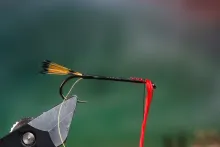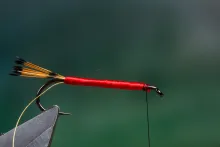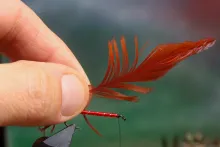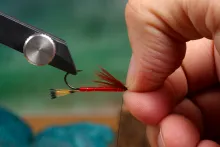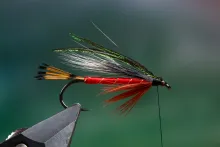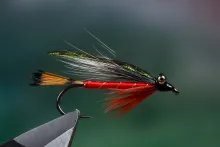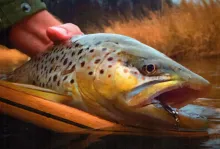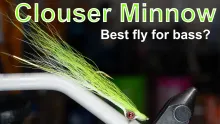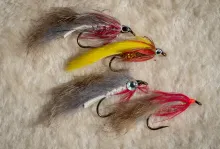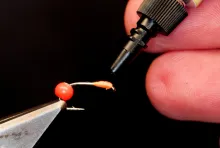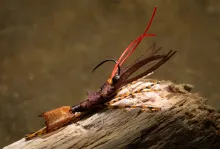With names that sounded fresh, in-your-face and downright sexy, the Optic Fly series entered the stage like a warm summer wind in the 1960’s cold war era.
This article is a small excerpt from Danish Michael Jensen's book on the Swedish streamers known as Optic Flies. His book, entitled "ABU Optic Flies" was published early 2018 and contains an in depth coverage of these Scandinavian classics: their history and legacy, pattern descriptions and detailed step-by-step instructions on how to tie a number of the flies as well as tips to fish them properly.
Michael has give us permission to reprint a few sections of the book.
ABU Optic – an instant success
With names that sounded fresh, in-your-face and downright sexy, the Optic Fly series from Swedish tackle manufacturer ABU entered the stage like a warm summer wind in the 1960’s cold war era.
When the annual printed product catalog Tight Lines hit the tackle shops back in 1967 Callgirl, Streamtease, Pinup and Playboy suddenly became household names – and the small optic flies entered many fly boxes.
With 80,000 flies sold in the first season alone The Optic Flies series had a serious impact on fly fishermen worldwide. But, just as interesting: the hair winged flies also had a lot of spin fishermen wondering what this fly fishing business was all about.
Callgirl and me
I grew up in the sixties and seventies – and I remember the Optic Flies from my childhood, even though my first rod and reel was a spinning outfit. At that time spinning tackle didn’t get any better than the products made in Svängsta, Sweden. I read the Tight Lines as a Bible, and naturally I noticed the eye-catching Optic hair wing flies.
I was not into fly fishing back then, but these were some of the first flies I ever saw. When I actually took up fly fishing many years later, I chose the classic route: Reading Skues, Halford, Torp Jacobsen and a lot of other great fly tiers and -fishermen. Those guys, who I came to respect, weren’t really much into hair wing flies.
But I was – even though I don’t think Halford would approve. And the image of Callgirl and her friends kept bugging me until I finally found the first fly in an ad on an auction site. I won the auction and received a NOS (New Old Stock) Callgirl – still in the original display package. I guess I realized that old love never dies, so I started buying original Optic Flies when I had the opportunity.
Point is that back then flies were tied using natural materials like feathers, silk and in this case squirrel tail hair. Real classic fly tying materials that look great – but don’t last for centuries… unlike some of the new synthetic materials. So the old flies didn’t hold up well to hard use. After a few fish they died on me.
Being a fly tier, I decided to tie new Optic flies myself, but it proved difficult. I was not able to get hold of the original patterns, so I started researching: Getting hold of the old color plates from Tight Lines and studying the original flies I was able to get my hands on.
After a while I thought I had it all pinned down, but then I realized that some of the patterns seemed to change over the years. Not much, but there was a bit of inconsistency, which was kind of strange from ABU. Most of their product lines on the spinning side of things were consistent as clockwork – which wasn’t surprising when you know that their fishing tackle business was started by watchmakers.
Anyway, the small changes in some of the patterns seemed to have been made mainly to achieve a smooth running production – and not to improve the fish luring capabilities. So I decided to stay true to the early production of Optic flies in my tying recipes.
From 1969 and onward even fishermen using spinning tackle had the opportunity to enjoy the effectiveness of the Optic Flies. ABU offered the cool Magnette casting float. Paired up with the company’s tapered fly leaders this provided a long casting and effective setup for trout and grayling fishing.
Wild brown trout that grabbed an original vintage Callgirl Red. I caught this golden beauty while drifting in a boat and casting close up to the bank where shoals of baitfish were hiding in the reeds.
Back in the sixties when the Optic Flies hit the waters for the first time – this setup was the ultimate dream for ABU fans: The futuristic Delta 5 fly reel and the noble black and gold Diplomat 850 fly rod.
The Optic Streamer
"A new streamer of tremendous killing power." One quote from Tight Lines 1967 sums it up nicely. And these flies haven’t lost one bit of their killing power, even though most of us practice some form of catch and release these days.
For some people the word streamer refers to long flies tied with feather wings, while Bucktails or hair wing flies is tied with hair from different mammals. In recent years this line has blurred quite a lot, since streamers are tied with a variety of materials. Anyway, streamer was the word used in the Tight Lines magazines back then, so this is what I will use.
These small long shank hook flies started the whole Optic thing with the introduction of Playboy, Pinup, Streamtease and Callgirl. Four flies, each tied in three different body color variations (silver, red and black) made a total of a dozen different options. All made to tempt fish as well as fishermen into a solid hook-up.
As you already know that plan was a success, and very soon the first impressive catches were done worldwide.
Many of the patterns bear some resemblance to classic flies – but merge the past and present with some minor twists. The most prominent twist being the addition of the bead chain eyes.
All of these flies were available tied on classic streamer hooks in size 8 and 10. In my collection I have originals tied on several different hooks, but all seem to be 3x or 4x streamer hooks.
Anyway… let’s get on with some fly tying! Long, down eyed, bronzed finish streamer hooks. I have used the Ahrex Hooks NS118 Classic streamer. It has the classic look but a black nickel finish, which makes it equally useful in fresh- and saltwater. Naturally you can use your own preferred streamer hook.
Hand picked for this article
- Log in to post comments







